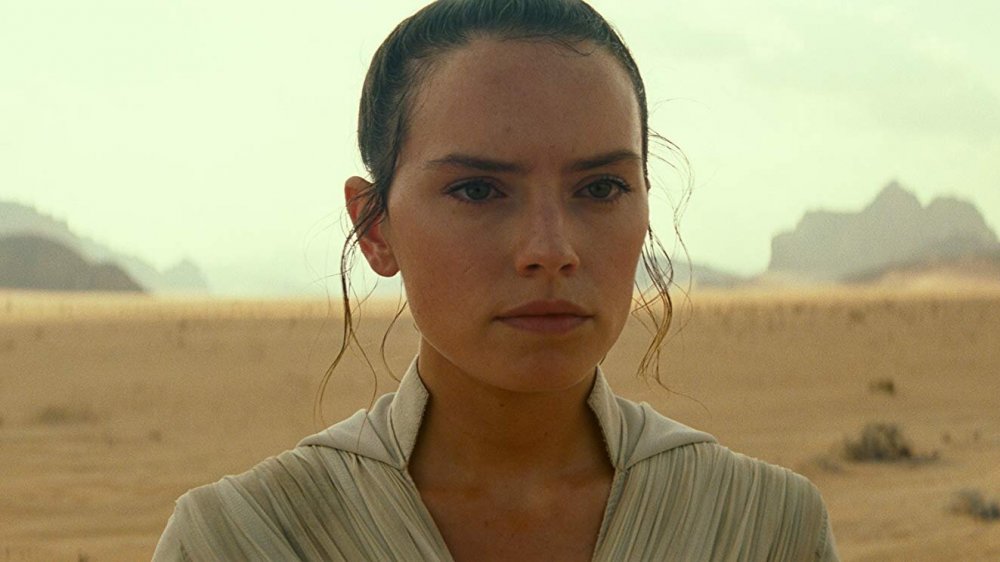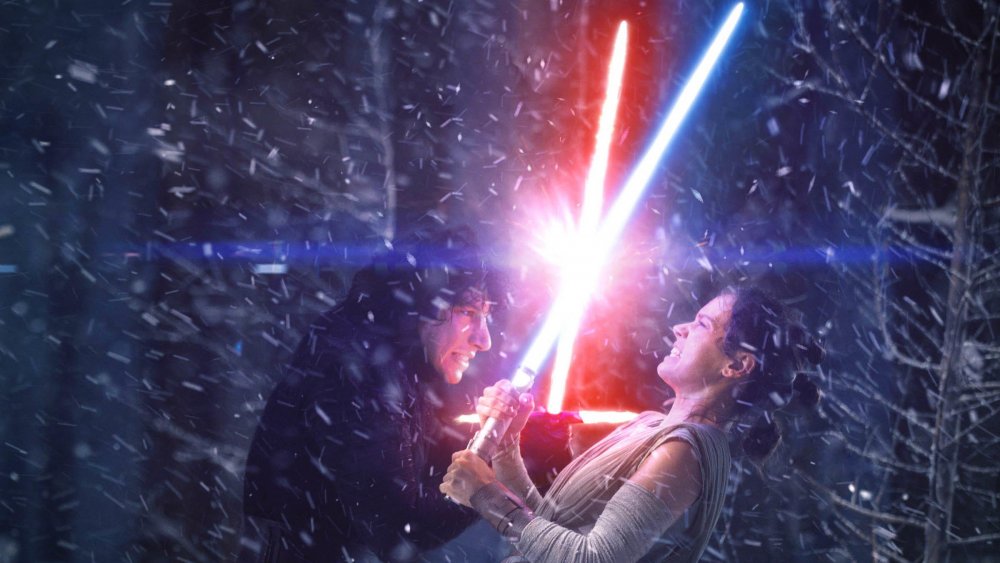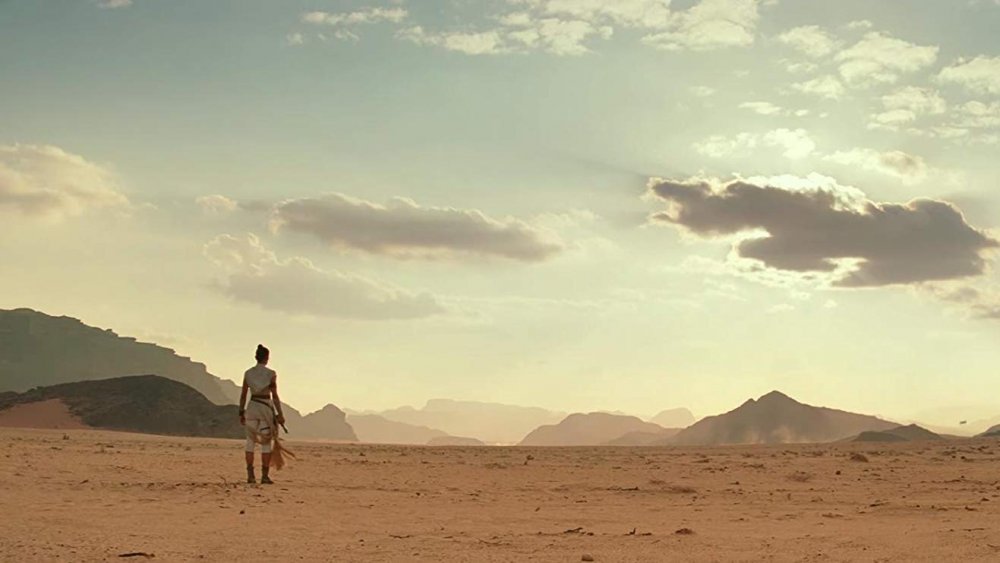J.J. Abrams Explains Rise Of Skywalker's Big Rey Twist
Contains spoilers for The Rise of Skywalker
The complicated, secretive lineage of the Skywalkers — and the galactic-sized choices resulting from that single familial identity — have been at the core of Star Wars since the very first film of the original trilogy. Thus, it's no surprise that after director J.J. Abrams officially launched the Star Wars sequel trilogy in 2015, The Force Awakens' parent-less Rey (Daisy Ridley) and the rest of the film's uncanny resemblances to George Lucas' initial journey into a galaxy far, far away ignited fans' intense curiosity.
From that point on, fans new and old spent the next several years mapping numerous theories about who and what Rey was. Many guessed that Rey could be the daughter of Han Solo (Harrison Ford) and Leia (the late Carrie Fisher). Some speculated she was Luke Skywalker's (Mark Hamill) child. And more recently, people believed she was the kin of Keri Russell's fashionable scoundrel Zorri Bliss. Others tossed around the idea that she could be a clone of Luke – or even, more simply, a powerfully gifted "nobody" like many others in the Jedi Order. But with the release of The Rise of Skywalker, Abrams has finally delivered to both its keen, hawk-eyed obsessives and general audiences the final answer.
Rey is both a nobody and a somebody — an orphan born not of golden Skywalker parentage, but from one of the most infamous families in all the galaxy. Rey is the granddaughter of a dark and indisputably powerful player: Emperor Palpatine.
That duality of Rey's existence is layered in that she didn't come from practically nothing after being raised by just anybody, she's actually born from evil — an arguably even worse place to sprout from than being born into a nobody family. Drawing that connection between place, choice, and identity was something The Rise of Skywalker director Abrams didn't just appreciate about the early films, but also wanted to drive home in the final chapter of the Skywalker saga.
At a Rise of Skywalker post-screening Q&A session (via CinemaBlend), Abrams explained the meaning and importance behind the big Rey twist.
"I don't know if it resonates for everyone, but I think there are quite a few people who appreciate that idea of not coming from a place that you're particularly excited about or proud of. Though I completely understand 'you're nobody' is a devastating thing, to me the more painful, the more shocking thing was 'you're from the worst possible place,'" he said. "Is that thing that you feel, that you know is part of you, somehow, that you're haunted by, is that your destiny? [...] There are things more powerful than blood, as Luke says. That feeling was an important thing to convey for us."
The Rise of Skywalker team conveyed this — to wildly different fan response and critical reaction – through Rey's final choice to honor Luke and Leia. Despite being Emperor Palpatine's granddaughter, Rey takes up the Skywalker mantle from the one who initially rejected it — Ben Solo (Adam Driver), formerly known as Kylo Ren. Rey isn't of Skywalker lineage by blood, but she chooses to be a part of the famous family. Her decision rejects the idea that what we are born of defines our path and our potential for — and even the kind of – greatness we can achieve. Those who saw that message come across clearly while viewing The Rise of Skywalker understood what was at the heart of both Rey's and the entire sequel trilogy's journey for Abrams.
Rey's story was about embracing the interconnectedness of the Star Wars films
Rey's journey and the messages behind it aren't by any means new to the Star Wars universe. In fact, they were very clearly tackled in both the prequels and original trilogy through their leads Anakin and Luke Skywalker, the doomed father-son duo on opposing sides of the Force. With Rey, Abrams simply had a chance to build on the franchise's long-running creative metaphors. It was also a chance to use Rey's link with Palpatine — a near mirror image to Anakin and Luke's connection — to create a continuity that would cement the narrative and creative legacy of the Star Wars universe, according to the director.
"This whole trilogy, this 7, 8, and 9, is really about the generation that sort of follows the great generation and the idea of balance, bringing balance to the Force, which is the whole point of the chosen one Anakin in the original trilogy," Abrams said during the same post-screening Q&A. "The idea that these two main characters — both the grandchildren of these crucially important characters of Palpatine and Skywalker — as [co-writer] Chris [Terrio] was saying, these two houses coming together in this next generation felt like there was an inevitability to it. And if one were to watch [Episodes] 1 through 9, you know, 50, 100 years from now, hopefully, you feel that these stories were inevitably leading there."
Abrams' comments clarify how the decision to make Rey the granddaughter of Palpatine wasn't just about a wild twist. It was both an extension of Star Wars' significant messages and a means of literally linking all three trilogies together. So yes, Rey could have been anyone's child, and yes, there might be plot holes around her connection to Palpatine. But that chosen familial bond does what Disney CEO Bob Iger said the latest trilogy wanted to do: touch on the franchise's long-standing themes while going to new places.
Yet, while the twists and turns for both the Palpatine and Skywalker lineage may now be settled as far as Abrams is concerned, the story behind the power that ultimately linked those houses together is not.
The Rise of Skywalker also underscored the battle over good and evil never ends
The habit of Hollywood trilogies is to wrap as many loose ends by their third installment as possible. So for fans who weren't reading Star Wars comics, watching the animated TV series, or buying various Star Wars dictionaries and resource companions, it's easy to see how the end of the Skywalker saga might seem like the end of the battle for balance. But the light and the dark — in all its literal and metaphorical Star Wars iterations — existed long before Anakin, Luke, or Rey. That's why it would be odd to see the fight over the Force be tied up with a perfectly wrapped bow. It would also cut the entire Star Wars universe off at its knees, severely limiting what could happen in future chapters.
Delivering a sequel trilogy may have meant putting an end to this specific Jedi family's story, but it doubled as a way for Abrams to send another message. For The Rise of Skywalker director, the fights between good and evil, destiny and intentionality, are actually never-ending. Abrams said at the post-screening Q&A that balancing the Force has to be an active — not passive — thing in Star Wars, and he loved how The Rise of Skywalker addressed that.
"What I love was the idea that balance brought to the Force doesn't mean it's forever," Abrams said. "It's not immediately everlasting. And I think the idea that if we are not careful, the evil will rise again. That we have to be proactive in doing what we can and maintain the balance, and how does the generation that follows the great generation do that."
Star Wars has always been about themes of family, destiny, morality, and the circularity of human behavior. To end the Skywalker saga, Rey's own story had to reflect nearly every corner of that.


